Smooth Adler Smooth alder is a nitrogen-fixing, thicket-forming shrub or small tree with dark, green foliage. It is aU.S. native. It is suitable for streambank stabilization because of its flexible stems and fibrous root system. A mature height of 8-12 feet may be reached in 10 years. Seed is produced in small cones with pollen contributed by birch-like catkins which bloom in mid-to late March. | 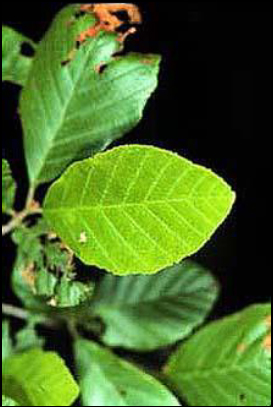 |
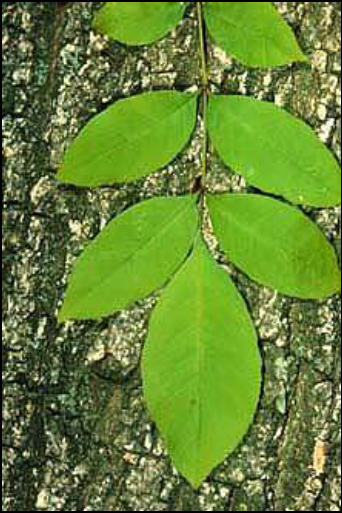
| Green Ash Fraxinus pennsylvanica Marsh., green ash, is a deciduous, medium-sized tree with an open, irregular crown reaching about 50 feet in height. Native to eastern North America and is fairly common west to Wyoming and Colorado along plains watercourses at elevations below 6,000 feet. The tree is fast growing on moist bottomlands, and is extremely hardy to climatic extremes once established. |
Pumpkin Ash Leaf: Opposite, pinnately compound, 7 to 9 leaflets, each leaflet 3 to 6 inches long, elliptical to lanceolate, entire or slightly serrated, dark green above, paler and velvety below.
Flower: Dioecious; in clusters, green to purple, appearing in spring.
Fruit: One-winged, flattened samara, 2 to 3 inches long, 1/2 inch wide, wing extends nearly to base, wider than green or white ash.
Twig: Stout, fuzzy, light gray-brown, leaf scar oval (not deeply notched); buds brown and scruffy.
Bark: Light gray-brown, interlacing ridges to nearly blocky.
Form: Medium sized tree up to 90 feet tall but typically smaller with a narrow open crown. When grown under flooded conditions the base of the trunk is clearly swollen. | 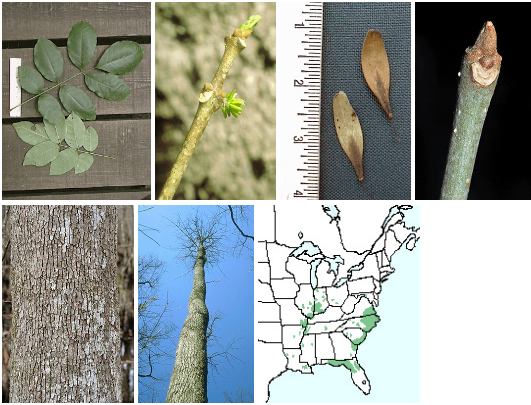 |
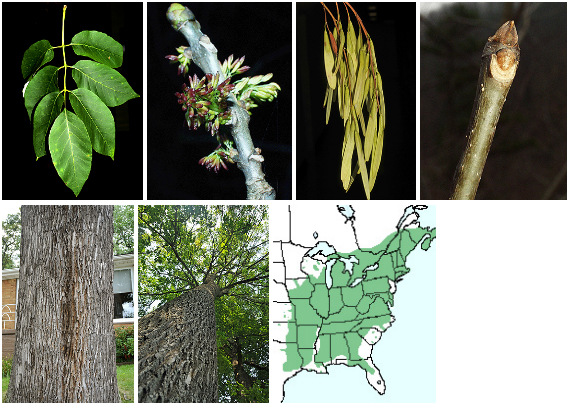 | White Ash Leaf: Opposite, pinnately compound with 7 serrate to entire leaflets that are ovate to somewhat lanceolate, 8 to 12 inches long, essentially hairless, green above and slightly paler below.
Flower: Dioecious; light green to purplish, both sexes lacking petals, females occuring in loose panicles, males in tighter clusters, appear after the leaves unfold.
Fruit: A one-winged, dry, flattened samara with a full, rounded, seed cavity, maturing in fall and dispersing over winter.
Twig: Stout, gray-olive-green, hairless, leaf scars round at the bottom, notched at the top, with lateral buds in the notch; terminal bud is large, brown, with leathery scales and flanked by two lateral buds.
Bark: Ashy gray to brown in color, with interlacing corky ridges forming obvious diamonds; older trees may be scaly.
Form: A large tree up to 80 feet tall that typically develops a straight, clear bole (particularly on good sites), usually with a narrow oblong crown. |
American Beech Leaf: Alternate, simple, elliptical to oblong-ovate, 2 1/2 to 5 1/2 inches long, pinnately-veined, 11-14 pairs of veins, with each vein ending in a sharp distinct tooth, shiny green above, very waxy and smooth, slightly paler below.
Flower: Monoecious; male flowers borne on globose heads hanging from a slender 1 inch stalk, female flowers borne on shorter spikes, appearing just after leaves in the spring.
Fruit: Nuts are irregularly triangular, shiny brown and edible, found in pairs within a woody husk covered with spines, 1/2 to 3/4 inch long, maturing in the fall.
Twig: Very slender, zigzag, light brown in color; buds are long (3/4 inch), light brown, and slender, covered with overlapping scales (best described as “cigar-shaped”), widely divergent from the stems, almost looking like long thorns.
Bark: The bark is smooth, thin, and gray in color even on the largest stems. Beech bark diseases severely deforms the smooth bark.
Form: A medium to large tree up to 100 feet tall with a rounded crown. Often found in thickets produced by root suckering. Old trees may be surrounded by a ring of young beech. | 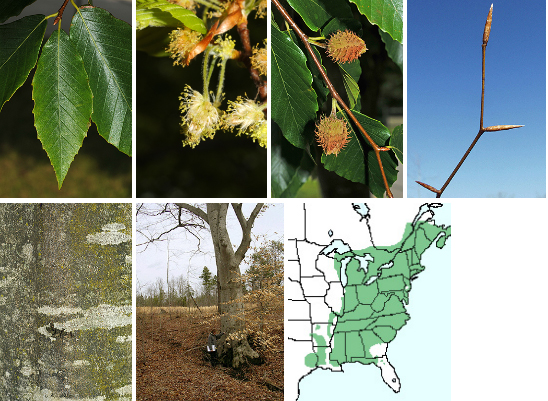 |
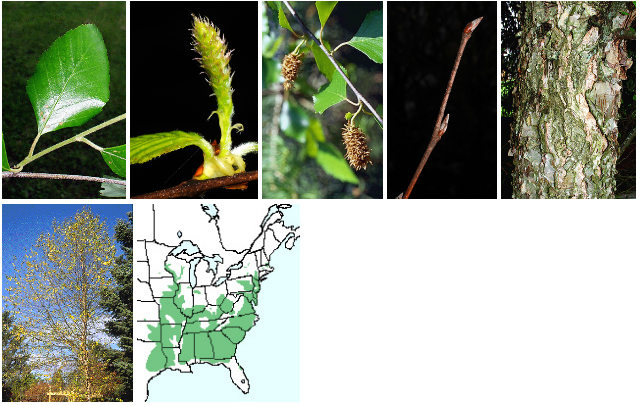
| River Birch Leaf: Alternate, simple, pinnately-veined, rhombic to ovate, 1 1/2 to 3 inches long, conspicuously doubly serrate, with a wedge-shaped base, green above, paler and fuzzy below.
Flower: Monoecious; preformed, reddish green, male catkins near the end of the twig, 2 to 3 inches long; female catkins upright, 1/4 to 1/2 inch long, light green, appear or elongate (males) in mid-spring.
Fruit: Cone-like, aggregate, 1 to 1 1/2 inches long, with many hairy scales, reddish brown, containing many tiny, 3-winged seeds, ripen and break apart in the fall.
Twig: Slender, orangish brown in color, smooth or slightly pubescent, with the terminal bud absent. Lateral buds may be slightly pubescent. No wintergreen odor when cut.
Bark: Smooth on young trees, salmon to rust colored; developing papery scales, exfoliating horizontally with several colors (creamy to orangish-brown) visible; later developing coarse scales.
Form: Medium size tree reaching up to 70 feet tall. The trunk generally divides low into several upright trunks. |
Butternut Leaf: Alternate, pinnately compound, 15 to 25 inches long, with 11 to 17 oblong-lanceolate leaflets with serrate margins; rachis is stout and pubescent with a well developed terminal leaflet; green above and paler below.
Flower: Monoecious; male flowers are single-stemmed, yellow-green catkins, 2 1/2 to 5 1/2 inches long; females are on a short spike near the end of the twig, green-yellow in color, appear in mid to late summer.
Fruit: Oblong (lemon shaped), with a yellow-green sticky indehiscent husk; husk contains an irregularly-ribbed nut containing sweet, oily meat; mature in late summer.
Twig: Stout, may be somewhat pubescent, yellow-brown to gray, with a chambered pith that is very dark brown in color; buds are large and covered with a few light colored pubescent scales; leaf scars are 3-lobed, resembling a “monkey face”; a tuft of pubescence is present above the leaf scar resembling an “eyebrow”.
Bark: Light, ashy gray, with flat top, shiny ridges, developing diamond shaped patterns.
Form: A small to medium sized tree up to 60 feet with a forked or crooked trunk and wide-spreading branches. | 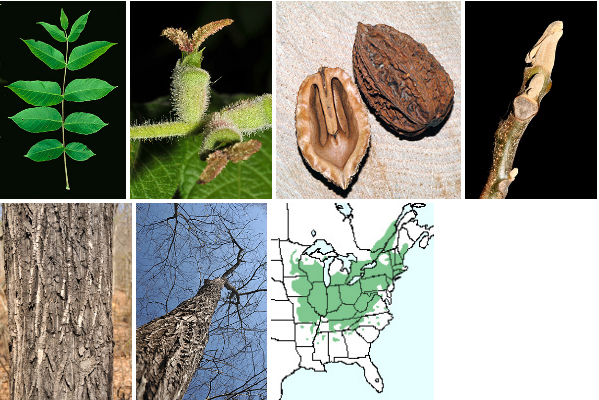 |
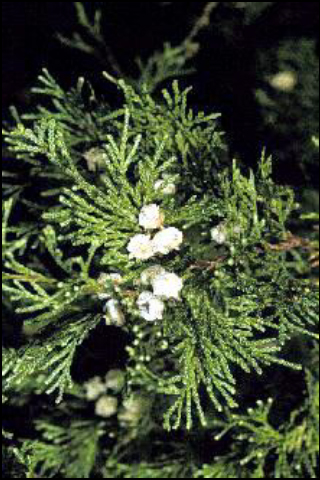 | Atlantic White Cedar Atlantic white cedar is one of only six species in this genus. Only three of the six are native to the continent, and two of them are west coast species. This leaves Atlantic white cedar as the only representative in the East, where it occurs in a narrow band along the Atlantic coast. Atlantic white cedar is an evergreen with scaly leaves that occur in a flat fern-like appearance. This species usually grows in very dense, solid stands, and has small rounded cones. |
Red Cedar Leaf: Evergreen, very small, with two types of leaves (often on the same tree), scale-like leaves 1/16 inch long, dark green, with 4 sides held tightly to twig and longer (1/4 inch), dark blue-green needle-like leaves that are more common on young trees and fast growing shoots.
Flower: Dioecious; but occasionally monoecious; males are small, yellow-brown, occurring in large groups; females are light blue-green.
Fruit: Berry-like cones, light green in spring, turning dark blue and glaucous at maturity, about 1/4 inch in diameter, appearing in spring and maturing in the fall.
Twig: Green for several years, covered in scales, later turning brown.
Bark: Red-brown in color, exfoliating in long, fibrous strips, often ashy gray where exposed.
Form: A small tree with a dense ovoid or columnar crown reaching up to 60 feet tall. | 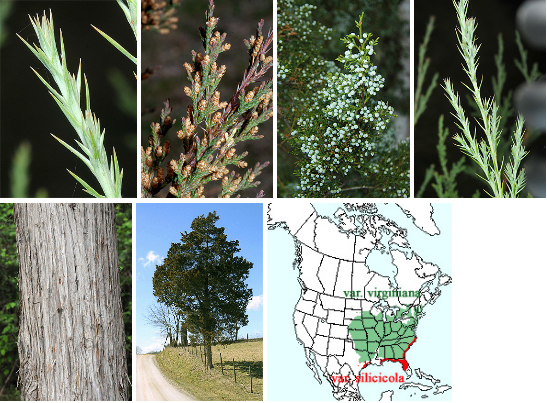 |
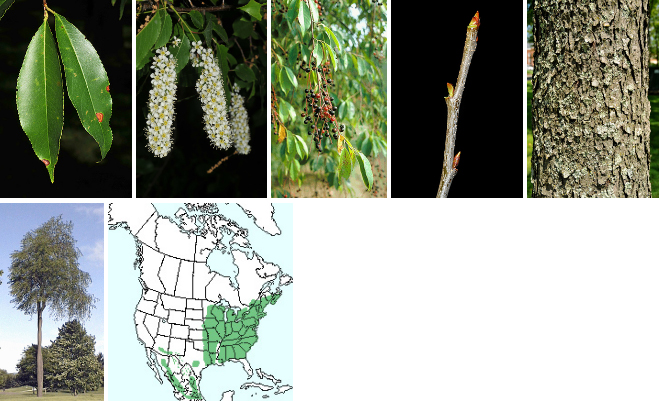 | Black Cherry Leaf: Alternate, simple, 2 to 5 inches long, oblong to lance-shaped, finely serrated, very small inconspicuous glands on petiole, dark green and lustrous above, paler below; usually with a dense yellowish-brown, sometimes white pubescence along mid-rib.
Flower: Small white flowers in hanging, narrow clusters 4 to 6 inches long, appearing in late spring.
Fruit: Dark purple round drupe, almost black when ripe, 1/3 inch in diameter with a bitter-sweet taste; matures in late summer.
Twig: Slender, reddish brown, sometimes covered in gray epidermis, pronounced bitter almond odor and taste; buds are very small (1/5 inch),covered in several glossy, reddish brown to greenish scales; leaf scars are small and semicircular with 3 bundle scars.
Bark: Smooth with numerous short, narrow, horizontal lenticels when young; becomes very dark (nearly black), breaking up into small, rough, irregular, upturned plates (burnt corn flakes), when older.
Form: Medium sized tree which (on good sites) develops a long, straight, clear bole and can reach heights approaching 100 feet. |
American Chestnut Leaf: Alternate, simple, oblong to lanceolate, 5 to 8 inches long, pinnately veined, sharply and coarsely serrated with each serration bearing a bristle tip, dark green above and paler below, both sides are hairless.
Flower: Monoecious; many small, pale green (nearly white) male flowers found tightly occuring along 6 to 8 inch catkins; females found near base of catkins (near twig); appearing in late spring to early summer.
Fruit: Large, round spiny husk (very sharp), 2 to 2 1/2 inch in diameter, enclosing 2 to 3 shiny, chestnut brown nuts, 1/2 to 1 inch in diameter, mostly round but flattened on 1 or 2 sides ripen in early fall.
Twig: Moderately stout, hairless, chestnut- to orange-brown in color, numerous lighter lenticels; buds are orange-brown, 1/4 inch long, covered with 2 or 3 scales (they somewhat resemble a kernel of wheat), buds are set slightly off center from semicircular leaf scar.
Bark: Smooth and chestnut-brown in color when young, later shallowly fissured into flat ridges, older trees develop distictive large, interlacing ridges and furrows. Blight infested bark is sunken and split, often with orange fungal fruiting bodies.
Form: Once a very tall, well formed, massive tree reaching over 100 feet tall. The chestnut is now found mostly as stump sprouts, less than 20 feet tall. Larger stems are often deformed by blight and sprouting below cankers. | 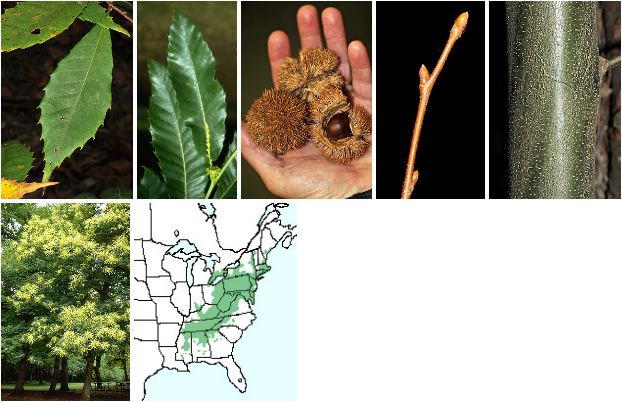
|
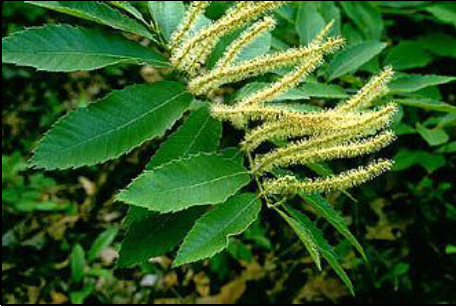 | Allegheny Chinkapin Allegheny chinkapin is a spreading shrub or small tree reaching a mature height of 20 feet under ideal conditions. The leaves are similar to the Chinese or American chestnut only smaller. They are 3-6 inches long with pointed teeth.
The nuts are enclosed in spiny burs about an inch in diameter and golden in color. By contrast, chestnuts are about twice as large and flattened on one side. The nuts of Allegheny chinkapin range from chocolate brown to blackish-brown. Nuts mature in late August in the South and in September and October farther north. Under favorable conditions, seedlings may produce nuts as early as the end of the second or third growing season. However, nut production is not significant until the fourth or fifth year. Six year old plants at the former Quicksand, Kentucky Plant Materials Center produced 1200-1500 nuts per plant. |
Bald Cypress Bald cypress is a large, slow-growing but long-lived, deciduous conifer, which frequently reaches 100 to 120 feet in height and 3 to 6 feet in diameter. Its trunk is massive, tapered and buttressed. The leaves are alternate, linear and flat with blades generally spreading around the twig. The bark is thin and fibrous with an interwoven pattern of narrow flat ridges and narrow furrows. Its male and female flowers form slender tassle-like structures near the edge of the branchlets. Bald cypress trees produces cone fruit, and there are approximately 5,200 seeds per pound. It develops a taproot as well as horizontal roots that lie just below the surface and extend 20 to 50 feet before bending down. It develops knees that grow above water providing additional support. | 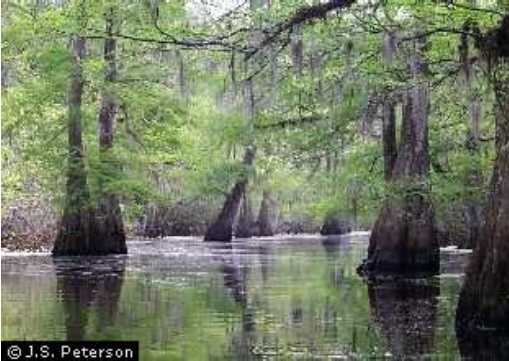 |
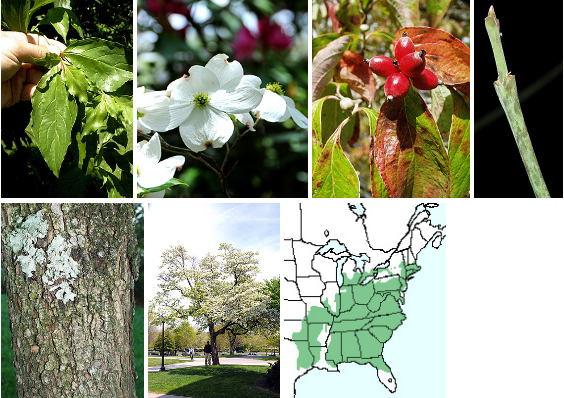 | American Elm Leaf: Opposite, simple, 3 to 5 inches long, oval in shape with an entire or slightly wavy margin, arcuately veined, green above and slightly paler below.
Flower: Monoecious; very small and inconspicuous tight cluster, but surrounded by 4 very showy, large, white (occasionally pink) bracts, 2 inches in diameter, appearing in mid-spring.
Fruit: A shiny, oval red drupe, 1/4 to 1/2 inch long, in clusters of 3 to 5, maturing in fall.
Twig: Slender, green or purple (purple on sunlit side), later turning gray, often with a glaucous bloom. The terminal flower buds are clove-shaped, vegetative buds resemble a dull cat claw.
Bark: Gray and smooth when young, turning very scaly to finely blocky.
Form: A small tree with a short trunk that branches low, producing a slightly rounded to flat-topped crown. Branches are opposite, and assume a “candelabra” appearance. |
Slippery Elm General: Elm Family (Ulmaceae). This graceful, arching tree reaches 20 m, with twigs that are scabrous-pubescent. It can live to be 200 years old and is identified by its “slippery” inner bark. The winter-buds are densely covered with red-brown hairs. The leaves are oblong to obovate, thick and stiff and 10-20 cm. They are pinnately veined and not equilateral. The flowers are subsessile in dense fascicles with 5-9 stamens. They appear before the leaves in the spring. The fruit is a flat, 1-seeded samara. It is suborbicular, 1.5-2 cm and pubescent over the seed. | 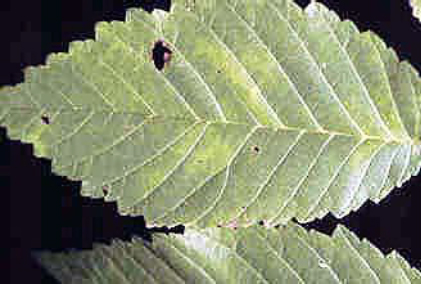 |
| | |
| | |















